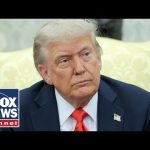The economic landscape in America is buzzing with excitement as Secretary of Commerce Howard Lutnick shares the latest developments on the horizon. With more than $15 trillion of committed investment poised to flow into the country, the potential for explosive economic growth is palpable. Lutnick paints a picture of a nation ready to thrive, attributing much of this momentum to Donald Trump’s strong-handed approach to trade deals and his determination to open foreign markets.
According to Lutnick, Trump has taken a proactive stance towards trade negotiations, exemplified by recent discussions with Indonesia. The policy is straightforward: open up the markets, eliminate tariffs, and invite American businesses to play a larger role in international trade. Such moves not only facilitate economic export but also offer a robust method for reducing the nation’s debt, as the administration believes that initiatives like these can effectively address the trade deficit on a step-by-step basis.
As the conversation pivots towards technology, it becomes clear that the future isn’t just about policy but also innovation. The rise of artificial intelligence (AI) is often compared to an arms race, and Lutnick’s optimism shines through as he underscores AI’s potential to revolutionize American manufacturing. With trillions in investment earmarked for the return of production facilities to the U.S., there is an urgent call for workforce development. The need is significant—about five million workers to fill roles in advanced manufacturing and automated plants. AI is not just a buzzword; it’s being touted as the key ingredient to make this vision a reality.
Transitioning back to the topic of investments, Lutnick emphasizes that we are on the brink of seeing transformative projects come to life. There’s a flurry of activity with groundwork already underway, as companies like Micron lead the charge by committing to massive investments in semiconductor manufacturing. Lutnick highlights that, in about a year’s time, Americans can expect to witness a noteworthy uptick in GDP growth attributed to these new factories. The optimism is infectious, as he suggests that the fruits of these investments will soon be visible, revitalizing the manufacturing sector.
With such sweeping changes on the horizon, Lutnick’s enthusiasm is understandable. In a world filled with uncertainty, these initiatives bring a renewed sense of hope. The focus on bolstering domestic production, enhancing technology, and fostering international relationships encapsulates a holistic approach that aims to not only keep the economy flourishing but also ensure that it thrives for generations to come. As Lutnick and Trump work together to usher in this new economic era, many Americans are left to ponder what this means for their own futures in a rapidly evolving landscape. The message is clear: the American economy is about to ignite like never before, and for those keeping an eye on these developments, the forthcoming year promises to be filled with exciting changes.




